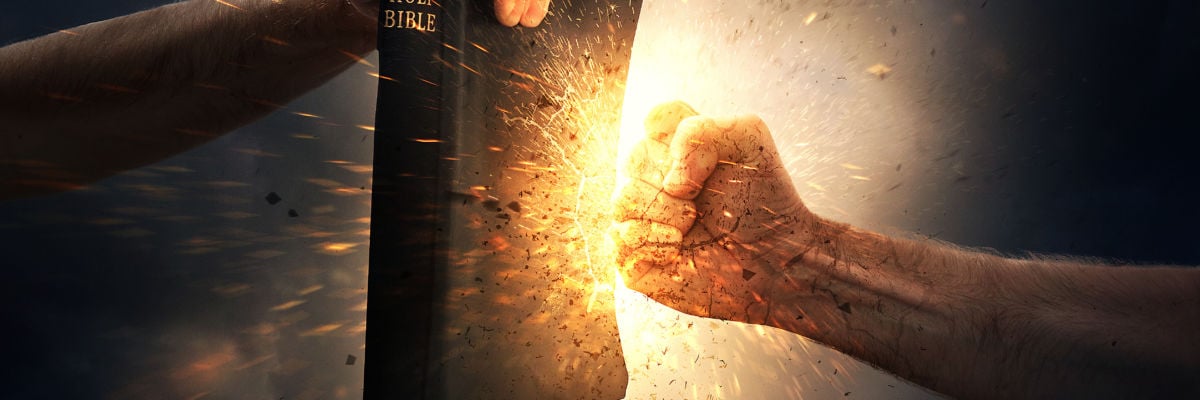
Way back in 1981, it was biblical archaeology that kick-started my interest in and call to Christian apologetics. It’s also what spurred me to write The Word Set in Stone. I discovered so many fascinating things, including new finds in archaeology—several from just the last few years. After everything I learned, I couldn’t help but be enthusiastic about passing along the information to others.
The Word Set in Stone was such a pleasure to research and write. It truly excited me and bolstered my faith. I believe that it can and will do the same for readers—obviously Christians, but also open-minded seekers and skeptics who have questions about the intersection of science and faith. It’s written from a general Christian perspective. Protestants and Orthodox shouldn’t be offended or put off by any “Catholic stuff” in it, and all Christians should agree on maybe 97 percent of its content.
How can The Word Set in Stone bolster belief in and persuade folks of the inspired and infallible nature of Holy Scripture? Here are four ways:
1) Its popular, non-academic level approach, without sacrificing serious academic scientific corroboration.
2) The “general Christian” presentation. I could have written this book as an evangelical Protestant with no change except for removing a few “footnote-like” and strictly optional, non-essential clarifications of Catholic Church teachings.
3) The simultaneously exciting, faith-boosting, and educational nature of the subject matter.
4) The potential to utilize this information in sharing Christianity with non-believers, especially atheists and those skeptical of the Bible and the Christian faith.
I wrote in my Introduction (slightly condensed):
I want to deal with specific objective matters in relation to the text of the Bible that can be addressed by archaeology or other forms of science, starting with premises (for the most part) that Christians and non-Christians accept in common. What I’m doing is “defeating the defeaters” offered up by biblical skeptics, anti-theist atheists. If they argue, for example, that a particular city wasn’t in existence when the Bible says it was, then, in response, I seek archaeological data to prove or at least offer strong evidential support for the biblical view. This approach defends the Bible’s accuracy.
Skeptical arguments against biblical accuracy are often incorrect and fallacious. In other words, if a skeptic contends, “The Bible is inaccurate history and therefore clearly not inspired because of errors a, b, c, d, e, and f,” I will argue via secular science—most often, but not exclusively, archaeology—that supposed errors a, b, c, d, e, and f are actually not errors and can almost always be resolved in a way that is consistent with belief in biblical inspiration.
This book deals with objective, historical issues that we can analyze through the means of scientific (mostly archaeological) analysis. It’s what Christians are often asked to do: give solid evidence for what we believe.
I tried my best to provide a “fresh” analysis that incorporated many truly “cutting-edge” discoveries. Our age is an invigorating period of biblical archaeology, with so many new finds being presented virtually on a monthly basis. What scientists are learning is no less than astonishing, and it all affirms the historical accuracy of the Bible. I take the reader on a fun tour of what has been happening in the field. And quite often, I am responding to actual atheist objections, expressed personally to me. Thus, the book has an “on the field” flavor to it.
Here are some of the subjects tackled in the book:
- Evidence for the existence of the Pishon River, which the Bible (Gen. 2:10-12) says flowed out of the Garden of Eden, discovered in satellite photos that suggest a dry river bed in Saudi Arabia, consistent with other geographical and mineralogical clues mentioned in the Bible.
- Analogies of the great Mississippi River flood of 1926-27 to Noah’s Flood. The former involved rainfall for eight straight months, and it took an entire year to totally dry up, compared to ten and a half months for Noah’s Flood (Gen. 7:11, 8:13).
- Scientific, chemical evidence that a “meteoritic airburst event” obliterated the area of Sodom and Gomorrah between 1750 and 1650 B.C. (cf. Gen. 19:24).
- Many archaeological and historical evidences supporting several aspects of the story of Joseph (born c. 1737-1717 B.C.) in Egypt.
- Serious scientific analysis (a phenomenon called “wind setdown”) suggesting a possible and plausible explanation for the parting of the Red Sea.
- Scientific support for a natural explanation of the quails in the wilderness, and Moses (c. 1340 or 1330 to c. 1220 or 1210 B.C.) drawing water from rocks.
- A plausible theory involving a salt-induced erosion process called haloclasty that adequately explains, I believe, why the walls of Jericho from the time of Joshua seem to have disappeared.
- The remarkable mounting evidence for the historical King David (r. c. 1010-c. 970 B.C.) and his kingdom, starting with the famous Tel Dan Stele, found in 1993.
- Various “fantastic” elements of the book of Daniel, analyzed as plausible historical events, rightly understood.
- An astronomically backed theory of what accounted for the star of Bethlehem, including a possible different death date for Herod the Great (which would change the “standard” birthdate for Jesus), and the fascinating celestial phenomenon called retrograde motion of the planets, which we know was already understood by ancient Babylonians and Persian sky-gazers. Consider the story in a new light, based on typical phenomenological biblical language and the support of the records of astronomy.
- Dozens of archaeological and historiographical evidences for the incredible and minute accuracy of the Gospels of Luke and John and the book of Acts.
Many readers have stated that The Word Set in Stone was difficult to put down. Heartfelt thanks to all my present and future readers!


